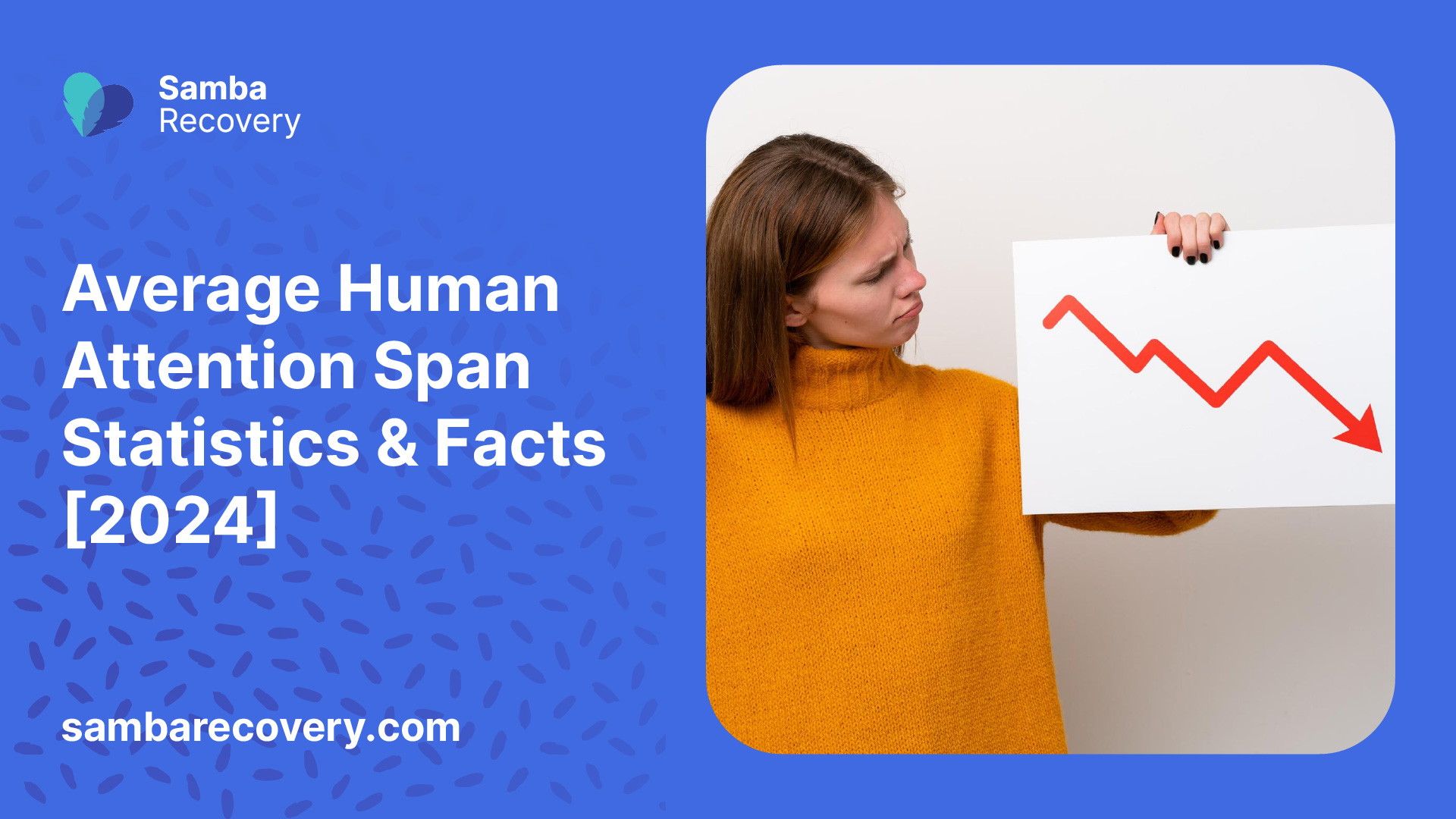Top 10 Average Human Attention Span Statistics and Facts
Here are the top 10 statistics about human attention span:
- The average human attention span is only 8.25 seconds, which is less than the goldfish’s 9-second attention span.
- The average adult internet user’s attention span is 8.25 seconds, influenced by the increasing distractions on the internet, social media, and the environment.
- The average attention span of a human has decreased significantly over the years, from 12 seconds in 2000 to 8 seconds in 2013.
- Childhood development experts suggest that a child’s attention span is approximately two to three minutes per year of their age.
- A study involving 262 individuals aged 7-85 found that attention span was longer in young adults than in children and older adults.
- Children had an average attention span of 29.61 seconds, experiencing an attention span decline of -27.41% over the course of the Continuous Performance Test.
- The attention span of teenagers increases with age. The average 14-year-old teenager has a 28 to 42 minute attention span, and the average 16-year-old teenager has a 32 to 48 minute attention span.
- Gender appears to influence attention span as well. Girls performed better in distractibility and impulsive reaction tendencies.
- Multitasking often leads to increased stress, fatigue, and reduced productivity.
- Prolonged screen time can have adverse effects on mental health, with 42% of individuals using electronic devices reporting experiencing adverse effects.
Understanding Attention Span
Attention span, the length of time a person can concentrate on a single task, activity, or stimulus, is a crucial aspect of cognitive functioning. It influences how we learn, work, and interact with our surroundings. This article sheds light on the average human attention span statistics and facts, illustrating how attention varies among individuals and changes over time.

Factors Influencing Attention
Several factors influence attention span among individuals. These include age, gender, overall health, stress levels, and environmental distractions. For instance, a study conducted on 105 children aged 6-10 years attending primary schools in Italy showed that gender and school grade significantly impacted attentional performance. Girls performed better in distractibility and impulsive reaction tendencies, while higher school grades positively influenced divided and sustained attention [1].
The digital environment also plays a critical role in shaping attention span. The average adult internet user’s attention span is 8.25 seconds, influenced by the increasing distractions on the internet, social media, and the environment [2].
Age and Attention Span
Age significantly influences attention span. Childhood development experts suggest that a child’s attention span is two to three minutes per year of their age. For example, the average 14-year-old teenager has a 28 to 42-minute attention span, and the average 16-year-old teenager has a 32 to 48-minute attention span.
In a broader context, a study conducted on a population of 262 individuals aged 7-85 found that attention span was longer in young adults than in children and older adults. Children had an A-span of 29.61 seconds, young adults had an A-span of 76.24 seconds, and older adults had an A-span of 67.01 seconds. The study also noted that A-span decrements were most pronounced in children, who experienced an A-span decline of -27.41% over the course of the CPT, while young and older adults experienced non-significant A-span decrements (-2.54% and -8.40%, respectively).
Interestingly, the average attention span of a human is only 8.25 seconds, which is less than the goldfish’s 9-second attention span [2].
These statistics illustrate the dynamic nature of attention span and its correlation with age. As we continue to delve into the average human attention span statistics, we’ll observe how this cognitive function changes across different age groups and how it is influenced by various external and internal factors.
Statistics on Attention Span
In the fast-paced world of today, understanding the average human attention span statistics can provide valuable insight into how people process and interact with information.
Historical Trends
The average human attention span has seen a significant decrease over the years. A study conducted by Microsoft in 2015 indicated that the average attention span reduced from 12 seconds in 2000 to 8 seconds in 2013. This can be visualized as the ability going from binge-watching an entire season of “Friends” to struggling to get through a single episode of “Keeping Up with the Kardashians”. In fact, between 2000 and 2015, research has shown that human attention spans shrank by a whopping 25%.
| Year | Average Attention Span (Seconds) |
|---|---|
| 2000 | 12 |
| 2013 | 8 |
| 2015 | 8.25 |
Gender Disparities
Gender appears to influence attention span as well. A study that investigated attentional functions in 105 children aged 6-10 years found that girls performed better in distractibility and impulsive reaction tendencies.
Impact of Digital Devices
With the advent and widespread use of digital devices, their impact on attention span is noteworthy. The average attention span of a human is now only 8.25 seconds, which is less than the 9-second attention span of a goldfish [2]. Also, the average adult internet user’s attention span is 8.25 seconds, affected by the increasing distractions on the internet, social media, and the environment.
According to CNN, the average attention span on a screen decreased from 2 ½ minutes in 2004 to about 75 seconds and now people can only pay attention to one screen for an average of 47 seconds. People take about 25 minutes to refocus on a task after being distracted from an active work project and spend about 10 ½ minutes in any work project before being interrupted and switching to another work project.
| Year | Average Screen Attention Span (Seconds) |
|---|---|
| 2004 | 150 |
| 2013 | 75 |
| 2023 | 47 |
These statistics reveal the significant impact that digital devices and the fast-paced nature of the modern world have on our ability to focus and maintain attention.
Cognitive Implications
Given the increasing reliance on digital devices in our daily lives, it’s crucial to understand the cognitive implications associated with technology use—particularly when it comes to multitasking and screen time.
Multitasking Effects
Contrary to popular belief, multitasking is not an effective skill for most individuals. According to Dr. Gloria Mark, individuals cannot perform two effortful tasks simultaneously. Attempting to multitask by rapidly switching attention between tasks often leads to increased stress, fatigue, and reduced productivity CNN.
Moreover, children exposed to a wide array of stimuli from their devices are inadvertently trained to engage in multitasking behaviors, also referred to as attention shifting. This exposure can condition young children to seek instant gratification while subjecting themselves to excessive stimulation Source.
To counteract the negative effects of multitasking, it’s recommended to be mindful of technology usage and implement strategies like scheduling rote work during less alert times, using technology to block distractions, taking breaks when needed, and engaging in activities that require no mental effort CNN.
Screen Time Effects
The effects of prolonged screen time on mental health are significant. A considerable 42 percent of individuals using electronic devices report experiencing adverse effects on their mental health as a result of this technology use.
For teenagers, the lure of social networks is particularly high as they attempt to build their relationships and social structures online. Unfortunately, this can lead to overuse of technology. Research has shown that out of 2500 teenagers with ADHD, only 5.9% were naturally born with the disorder, while 81% developed it after 24 months of excessive technology use Source.
The impact of screen time on the average human attention span is significant and requires further exploration. As technology continues to evolve, it’s important to consider the cognitive implications and adapt our behaviors accordingly to safeguard our attention span and mental well-being.
Attention Span in Different Age Groups
Understanding the average human attention span is vital in various fields such as education, psychology, and marketing. It’s particularly important to recognize how attention spans can vary across different age groups. Here, we delve into the specifics of attention spans in children, teenagers, and adults, providing a comprehensive picture of average human attention span statistics & facts.
Children’s Attention Span
When it comes to children, their attention spans tend to be shorter when compared to adults. Childhood development experts suggest that a child’s attention span is approximately two to three minutes per year of their age. In a study involving 262 individuals aged 7-85, children had an average attention span of 29.61 seconds, experiencing an attention span decline of -27.41% over the course of the Continuous Performance Test.
Teenagers’ Attention Span
The attention span of teenagers increases with age. For instance, the average 14-year-old teenager has a 28 to 42 minute attention span, and the average 16-year-old teenager has a 32 to 48 minute attention span. While this is significantly longer than the attention span of children, it’s essential to note that teenagers’ attention span is still developing and can be influenced by various factors such as sleep, diet, and screen exposure.
Adults’ Attention Span
As individuals transition into adulthood, attention spans tend to stabilize. However, the average attention span of a human adult is only 8.25 seconds, which surprisingly, is less than a goldfish’s 9-second attention span. The average adult internet user’s attention span mirrors this at 8.25 seconds, influenced by increasing distractions on the internet, social media, and in the environment.
Moreover, while some adults can focus for extended periods such as 5 to 6 hours, many struggle to maintain concentration for longer durations.
| Age Group | Average Attention Span |
|---|---|
| Children | 29.61 seconds |
| Teenagers (14 years old) | 28 – 42 minutes |
| Teenagers (16 years old) | 32 – 48 minutes |
| Adults | 8.25 seconds |
These statistics underscore the variability in attention spans across different age groups, highlighting the importance of tailoring information and communication strategies to the target audience’s age. Understanding these differences can enable more effective teaching, learning, and engagement strategies across all age groups.
References
[1]: https://www.ncbi.nlm.nih.gov/pmc/articles/PMC6359051/
[2]: https://www.thetreetop.com/statistics/average-human-attention-span
[3]: https://www.ncbi.nlm.nih.gov/pmc/articles/PMC10621754/






